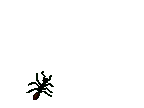 
Introduction
One of the first computers, which was owned
by the Navy, would not print some important data one day. After programmers spent many
hours trying to find the solution within the program, a woman named Grace Hopper decided to check
the computer. She found a small moth lodged between two wires. When she removed the moth,
the computer began working perfectly (although the moth didn't have as much luck).
The late Grace Hopper retired from the Navy
as a Rear Admiral. Although she was responsible for developing many important computer
concepts (she was the author of the original COBOL programming language), she might be
remembered best for discovering the first computer bug. Because an insect was discovered
to be the culprit in the Navy computer, errors in computer programs are known as computer
bugs.
When you test a program, you might have to debug
it--remove the bugs, or errors--by correcting your typing errors and changing the logic so
that the program does exactly what you want.
Definitions and Examples
As you know from the story above, looking for
and fixing program errors, or bugs, is called debugging. Most debugging should
take place while a program is still on paper--that is, before it is edited, interpreted,
and run. Errors fall into three general categories. When you find an error in a progam it
might be a syntax error, a run-time error, or a logic error.
Syntax Error
A syntax error is caused when an instruction does not follow the rules (or
grammar) of a programming language. Syntax errors can be caused by misspelling a command
word, or by using incorrect punctuation, such as a colon (:) when a semicolon (;) is
required. Many of today's programming language development tools point out syntax errors
as you type each line of code.
An example of a syntax error:
FR count = 1 TO 100
In this example, the command word FOR is misspelled and a syntax error occurs. If your
program will not run (execute), it is probably because you have a syntax error.
Run-time Error
A run-time error is an error that shows up when you
run a program. Errors that occur during the execution of a program are usually harder to
detect than syntax errors. They are usually fatal and cause the program to stop and an
error code or message is displayed. Run-time errors can be caused by logic errors or by
other mistakes made when writing the program.
An example of a run-time error:
Result = (100 + 550 - 320) / 0
This example will cause a division by zero run-time error. If
your program halts during execution, it is probably because you have a run-time error.
Logic Errors
A logic error is a special type of run-time error. A
logic error is the result of a mistake made in logic when the
program was designed or written. Sometimes when there is a logic error the program will
run perfectly, but produce meaningless results. Logic errors are hard to find and can be
corrected only by thoroughly testing
the program.
An example of a logic error:
IF price1 < price2 THEN PRINT "Pizza 2 is the best
deal for the money."
In this example a greater than symbol (>) should have been used. The user of the less
than (<) symbol produced a meaningless result and caused a logic error.
The Problems
Examine the code segments below and determine the type of
error(s) that would occur if you attempted to run the program. Note: It is not necessary
to type in the code to determine the types of errors. By now, you should be able to
recognize the errors on your own without the aid of a computer!
- PRNT "I cant't wait until Thanksgiving! I'm going to eat
and eat and eat!"
Type of error:_____________________________________________________________________
- week = 1
WHILE week = 1
PRINT "The semester is almost over! Whew!"
WEND
Type of error:_____________________________________________________________________
- totalAge = age1 + age2 + age3 + age4
numAge = 4
aveAge = numAge / totalAge
Type of error:_____________________________________________________________________
- sum = 0
FOR number = 10 TO 1 STEP 2
sum = sum + number
NEXT number
Type of error:_____________________________________________________________________
- INPUT "Please enter your groups golf scores:"
PRINT "First score ==>", score1
PRINT "Second score ==>", score2
PRINT "Third score ==>", score3
PRINT "Fourth score ==>", score4
TotalScore = score1 + score2 + score3 + score4
Type of error:_____________________________________________________________________
- FOR count = 1 TO 5
PRINT "This is line number: ";
count
Type of error:_____________________________________________________________________
- IF Grade >= 90 THEN PRINT "Yahoo! I got an A!"
IF Grade <= 90 THEN PRINT "I didn't get an A."
Type of error:_____________________________________________________________________
- LTE intern.name$ = Monica
Type of error:_____________________________________________________________________
- PRINT I like CSC001 so much, I'm going to major in C.S.
Type of error:_____________________________________________________________________
- times = 1
WHILE times <= 7
PRINT "Ha ";
times = times + 1
PRINT "The End"
Type of error:_____________________________________________________________________
|

